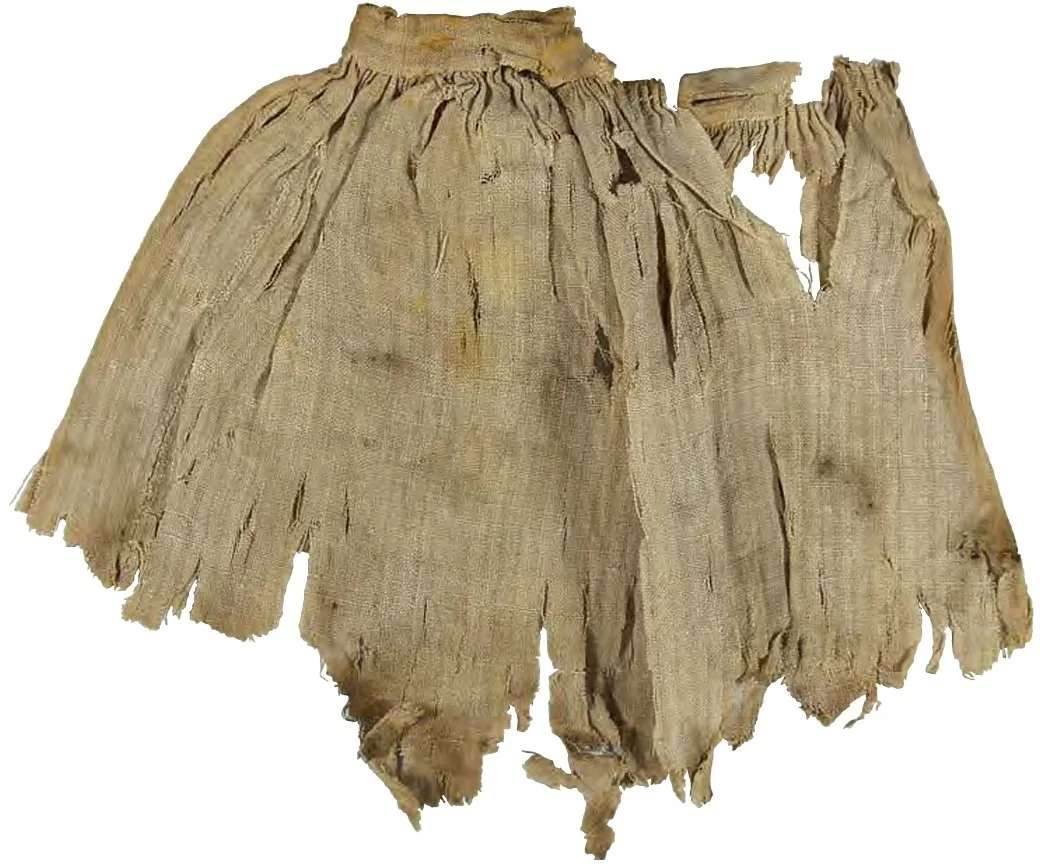18th Century Men’s Checked Shirts
Check shirts like these appear on working-class men in the 18th century; a gentleman would choose a shirt made from a more refined fabric, preferably in white. Illustrations and descriptions indicate that many of these shirts were made of a blue and white check.
We can also look at extant check aprons (e.g. Colonial Williamsburg 1999-225 & PVMA 1882.035.01) for samples of the sort of check linen available at the time. Check fustians also appear in sample books (e.g. Winterthur Col. 50, Acc. 07x005 & Met 156.4 T31) – but I don’t know whether these were intended for garments or other applications, such as slipcovers.
Runaway advertisements in colonial American newspapers describe thousands of men who wore check shirts – including enslaved men, teenaged apprentices, indentured servants, and convict servants.
Check shirts for sailors
Most of the illustrations of men wearing check shirts depict sailors. References from England (such as The Adventures of Roderick Random, An Account of the Loss of His Majesty's Ship Deal Castle, The Life and Adventures of Mr. Bampfylde-Moore Carew, Commonly Called the King of the Beggars, and Medicina Nautica: An Essay on the Diseases of Seamen) also primarily put them on sailors.
Voyage from Asia to America for Completing the Discoveries of the West Coast of America (1764) has a set of instructions for a watch-coat contrived by an officer that starts by cutting up a large checked shirt and applying boiled linseed oil; the result is “a ſort of ſurtout, to preſerve men, in a great meaſure, both from wet and cold.”
A checked shirt sleeve fragment was found on the shipwreck of the General Carleton of Whitby (1785). Regarding such shirts, the Babits & Brenckle report on sailor clothing indicates:
Seamen preferred blue and white checks [for shirts] above all else. The 1740 Royal Navy slop list calls for “Shirts of Blue and White Chequered linen, the sleeve 20 inches long, and 8 inches broad, with 4 buttons.” The Continental Marine Committee ordered “8400 Check Shirts” for the Continental Navy in 1779. In 1798, a London newspaper reported that “Bond Street dandies have taken to wearing check shirts and collars to make them look like sailors – our readers may suppose, not of the able-bodied kind!” So common were such shirts among seamen that “a press gang in Shropshire … seized a passing Irish collier just because he had a checked shirt in his pocket” …
The color on the checked shirt sleeve fragment (W-32/633/96) has completely faded, but it is possible to discern the check weave of the fabric. The checks are each 3/16 in. (5 mm) square. The sleeve is very finely gathered to the cuff. The most interesting feature is that the cuff fastened with sleeve buttons (cuff links). There is a 5/8 in. (1.59 cm) long buttonhole on each side of the cuff to accept the buttons.
Andrew Wilkinson, 1755
The Times, 1762
The human passions, 1773
A sticker-up of bills on Tower Hill at the Rendezvous at the King's Arms by Gabriel Bray, 1774
Seamen relaxing on the Pallas by Gabriel Bray, 1775
Bachelor’s Fare, or Bread and Cheese with Kisses, 1777
Watson and the Shark by John Singleton Copley, 1778; slightly less clear in the MFA 89.481 version
A scene at Vauxhall Stairs, 1779
Paul Jones shooting a sailor who had attempted to strike his colours in an engagement, 1779
The Embarkation by John Collet
The Sailor’s Return, or British Valor Rewarded, 1783
Historic Deerfield 1998.28, “Man's blue and white checked linen shirt which came from the Wakeman family of Westport, Conn,” 1780-1820
A sailor's shirt from the General Carleton shipwreck, 1785
An enslaved man playing a drum in Music and Dance in Beaufort County by John Rose, c. 1785
The Sailor, 1792
British Plenty, 1794
